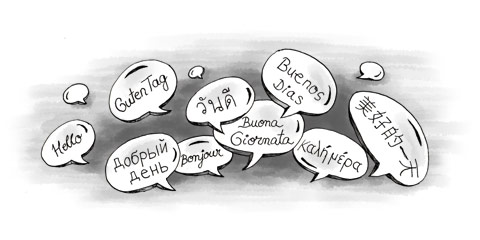Turkish is derived from a group of languages that come from Central Asia, Siberia, and Eastern Europe. It is somewhat disputed whether Turkish is an Oghuz language or an Altaic language. What is certain is that it has roots in both branches. The first known writings of Turkish are found as inscriptions on monuments in Mongolia.
There are three forms of the Turkish language: Anatolian Turkish, Ottoman Turkish and Modern Turkish. Anatolian Turkish was used from the 13th to the 15th centuries and was written in Arabic script. With the adoption of Islam, Persian and Arabic vocabulary began to modify the language and it became known as Ottoman Turkish between the 15th century to the early 20th century.
In 1928 there was a dramatic change when a “new language” movement was begun by Kemal Ataturk in which he strove to keep the language more pure. He changed the alphabet from Arabic to Latin, and he began the Turkish Language Association (Turk Dil Kurumu, or the TDK). The TDK strove to eradicate all foreign words and began replacing non-Turkish words with Turkish equivalents. This has created major differences in versions of the language spoken by different generations.
Turkish dialects
Istanbul Turkish is considered Standard Turkish, but there are many different dialects. These an be divided into Western and Eastern dialects. The main dialect in the Western group is known as Danubian, while the Eastern division contains many more such as, Eskisehir, Edirne, Dinler, Gaziantep, Karamanli, Razard, Rumelian, and Urfa.
Characteristics of the Turkish language
The Turkish alphabet consists of 21 consonants and 8 vowels. There are two types of vowels, dotted (e, i, ö, ü) and plain (a, i, o, u) vowels which you pronounce at the back of the throat. You pronounce dotted vowels at the front of the mouth and plain vowels at the back of the throat. Three main characteristics distinguish Turkish from other languages: vowel harmony, agglutination, and consonant mutation.
Vowel Harmony: Vowel harmony is one of the most important aspects of the Turkish language. Rules regulate vowel combinations, which creates better linguistic compatibility and makes the language easier on the tongue.
Agglutination: Agglutination (from the Latin word agglutinare, meaning “to glue to”) is a system of attaching suffixes to words to add meaning or grammatical forms.
Consonant Mutation: Consonant mutation refers to spelling changes indicating differences in pronunciation. Turkish is a phonetic language and consonant mutation helps maintain that phonetic structure. This happens in English as well (the word pretty changes to prettier, for example), but it is less common. The most frequent changes occur when words ending in -k- change to end in a soft g (ğ). Additionally, when a suffix begins in -d- it may change to a -t- when it is attached to a voiced consonant.
Adjectives: Adjectives are placed before nouns and do not have to agree in number. They do not change depending on whether a word is plural or singular. Turkish is a descriptive language and uses adjectives in abundance.
Gender and articles: There are no gender pronouns in Turkish (-o- is used for he, she, and it) nor are there definite articles (“the,” for example).
Verb Positioning: Verbs are always located at the end of Turkish sentences.
Declensions: Declensions are found in many languages, such as Latin, Russian, and German. Declensions modify nouns to indicate gender, number, and case, but since gender and number do not exist in Turkish there are only six cases:
- Nominative- The nominative case is the root word without a suffix
- Genitive- A possessive case, showing ownership. For example, the boy's ball...
- Dative- The dative case shows movement toward
- Accusative- Indicates the direct object of a verb
- Locative- Indicates location.
- Ablative- Indicates movement away from
Word Order: Turkish word order can be remembered as SOV, Subject Object Verb. This is a bit simplified but generally rings true.


